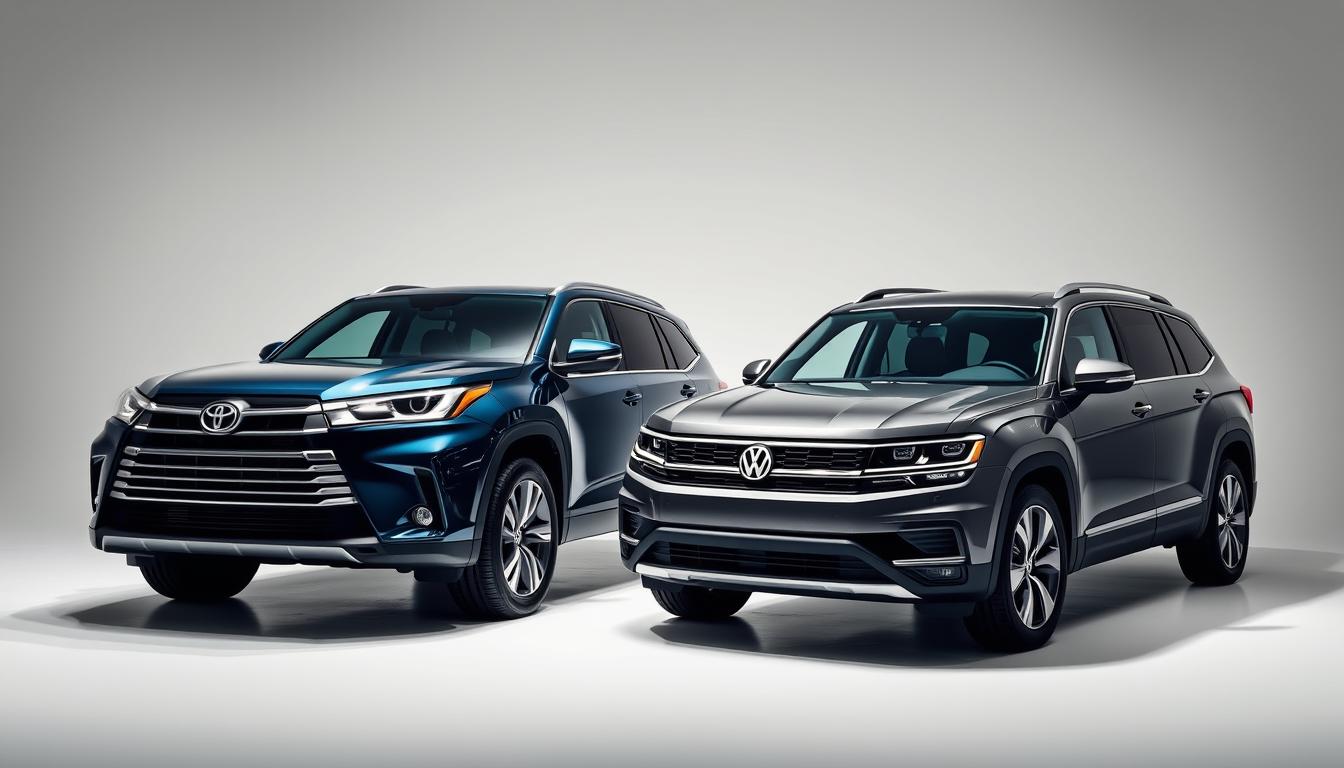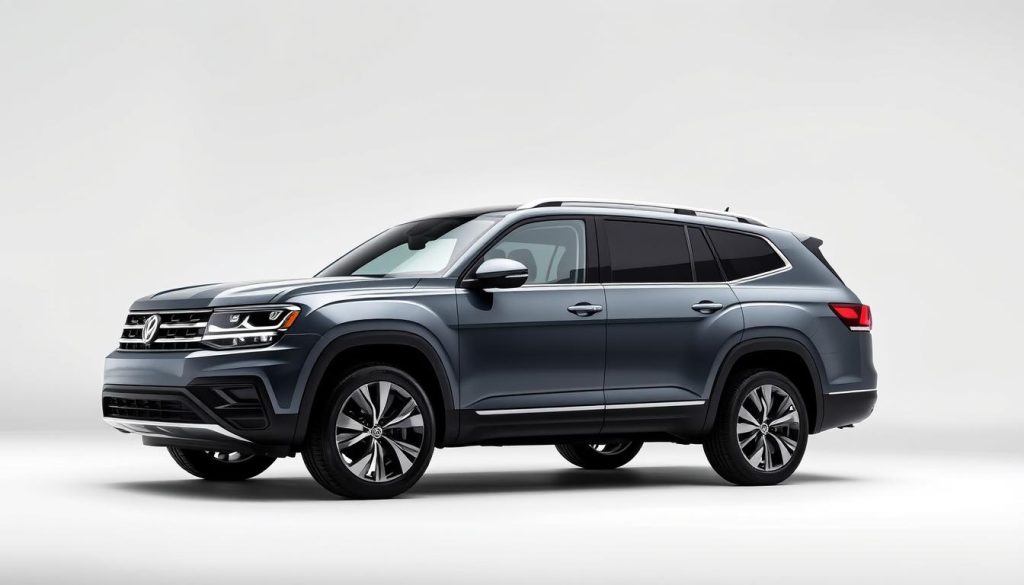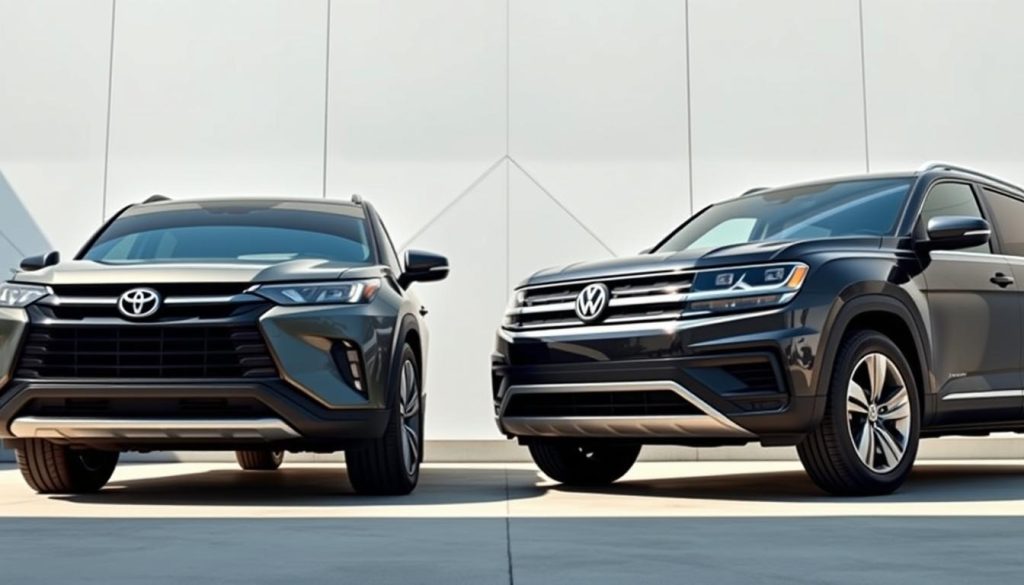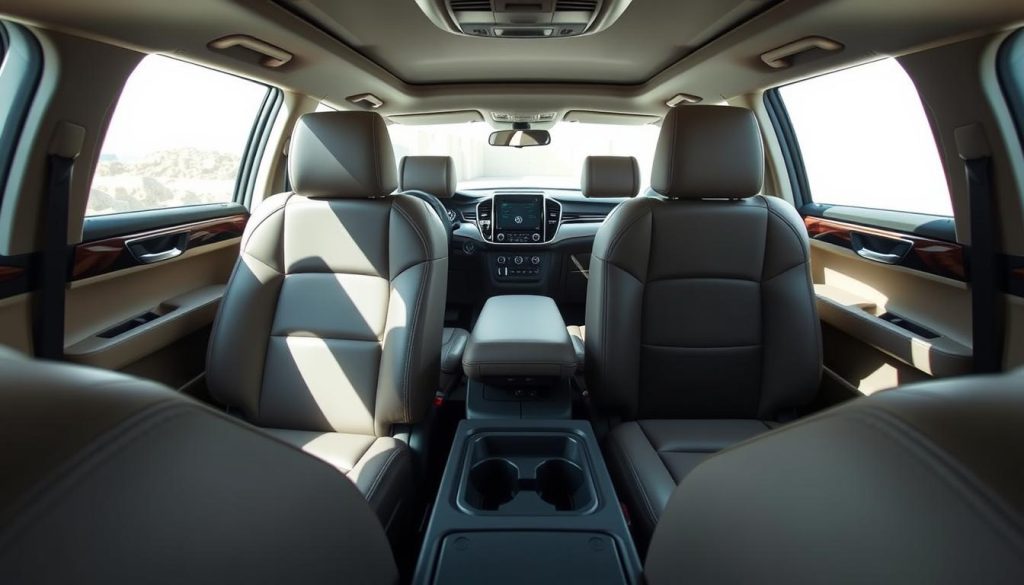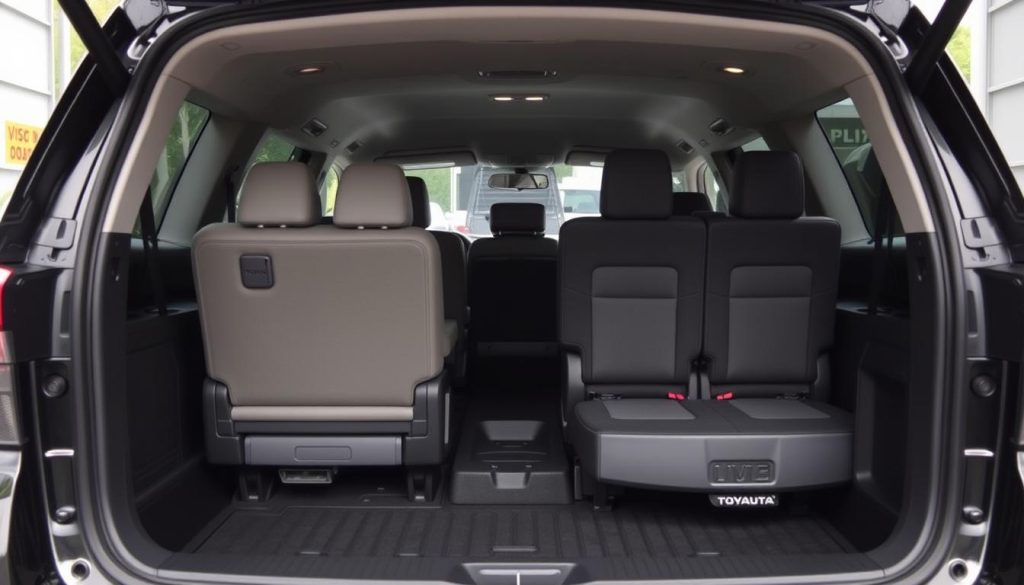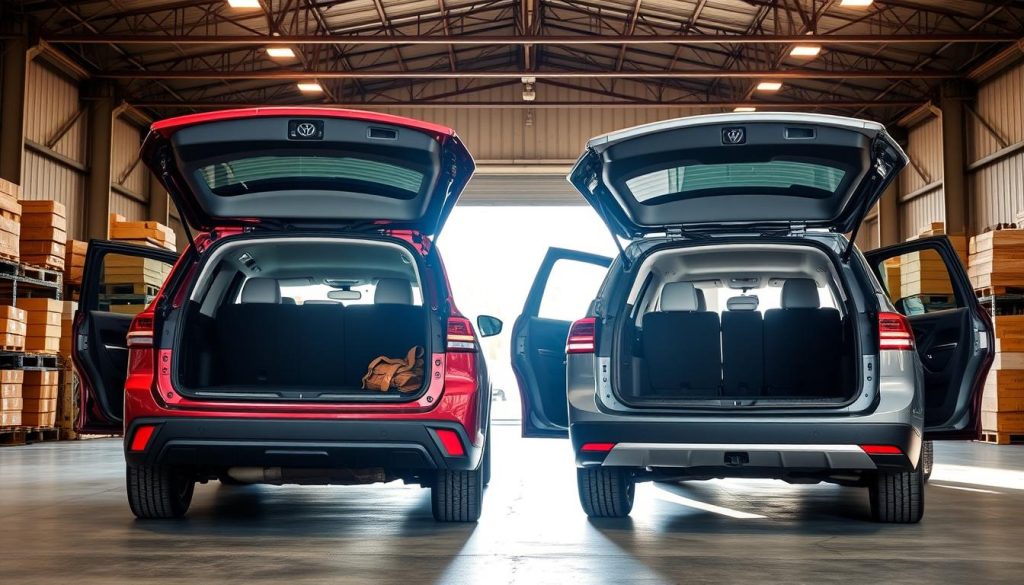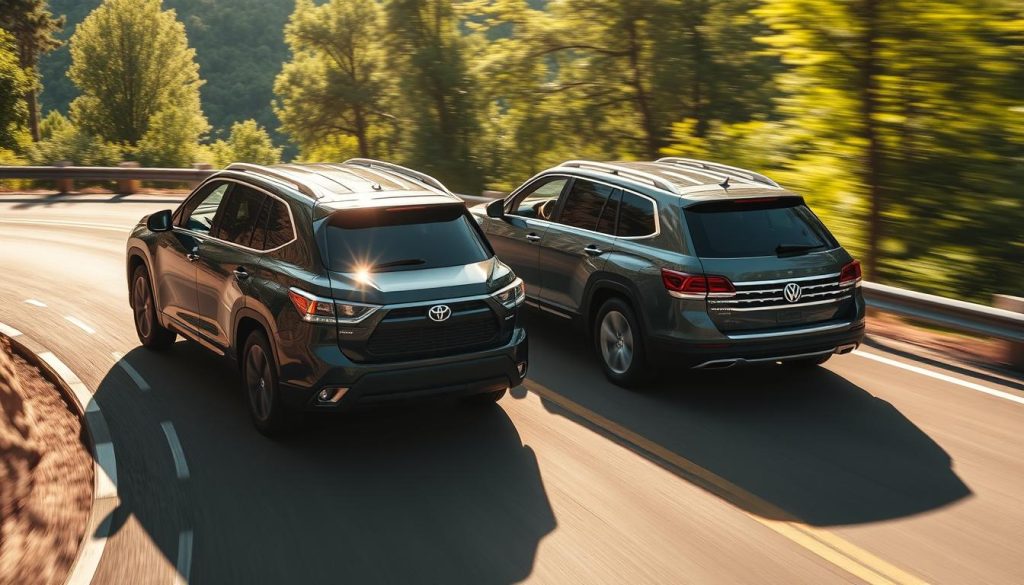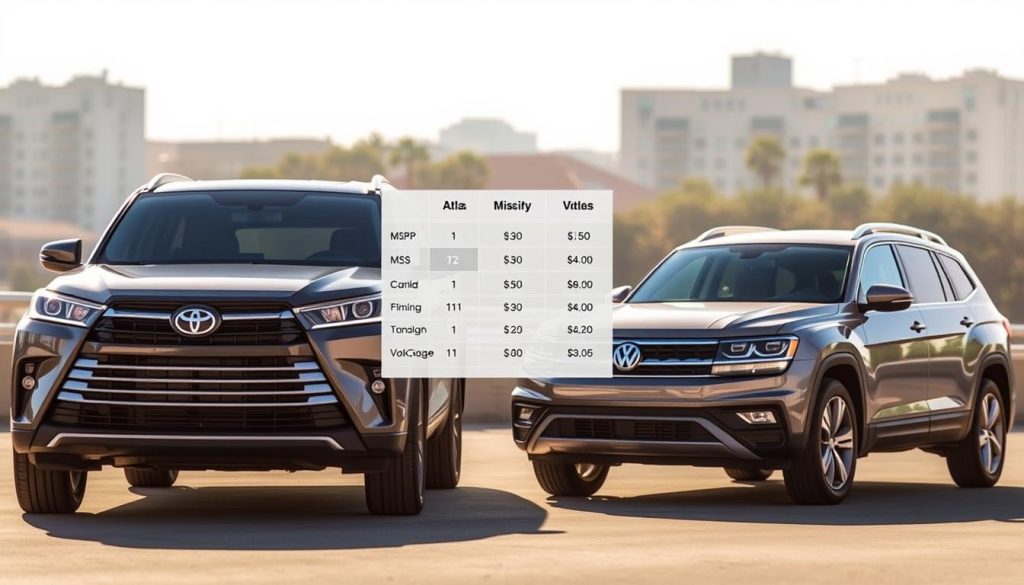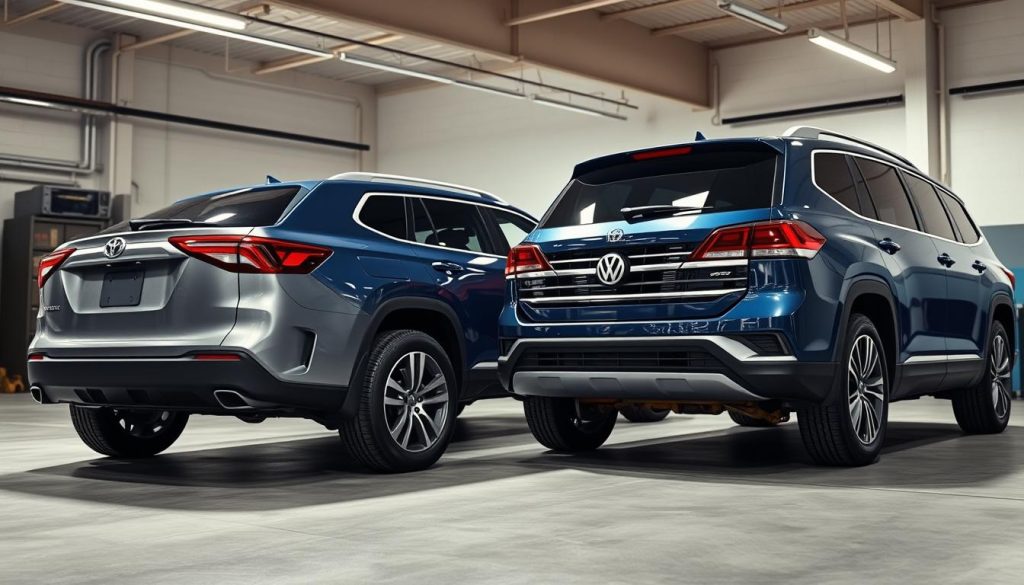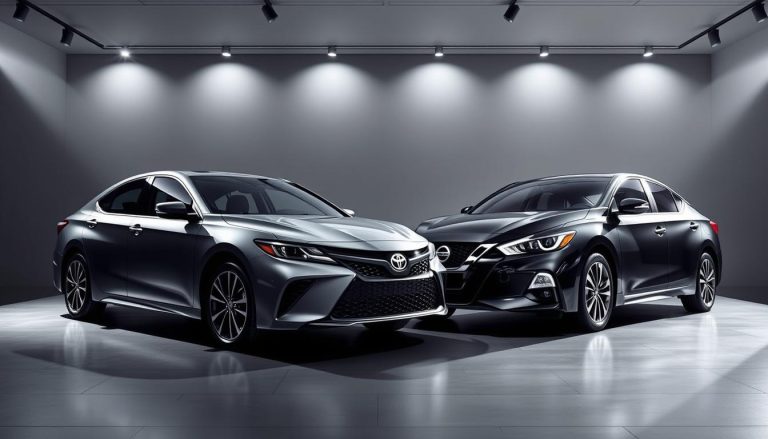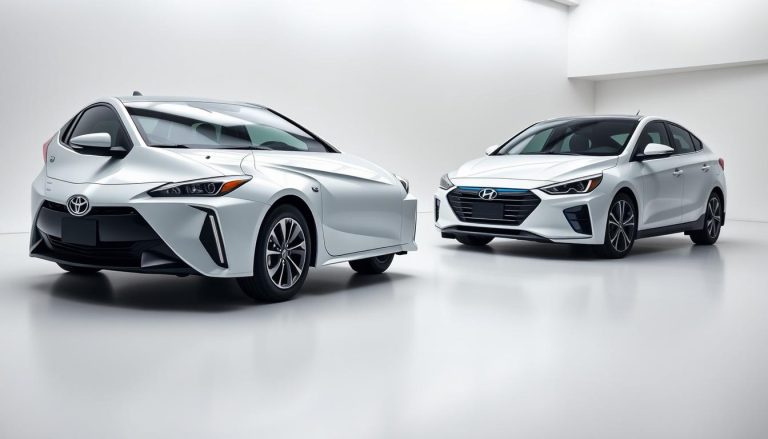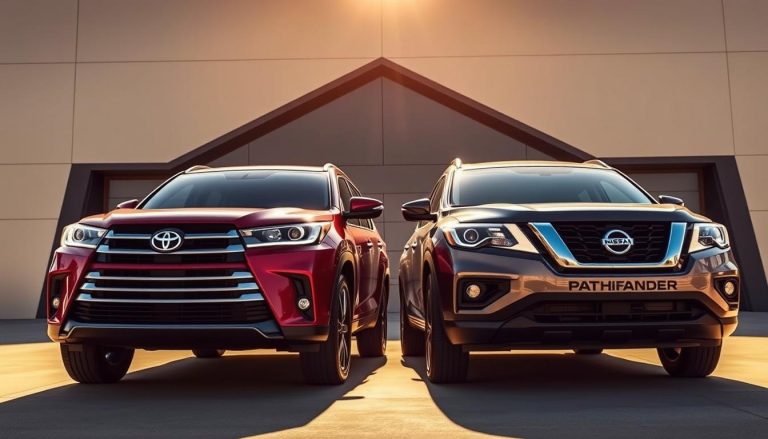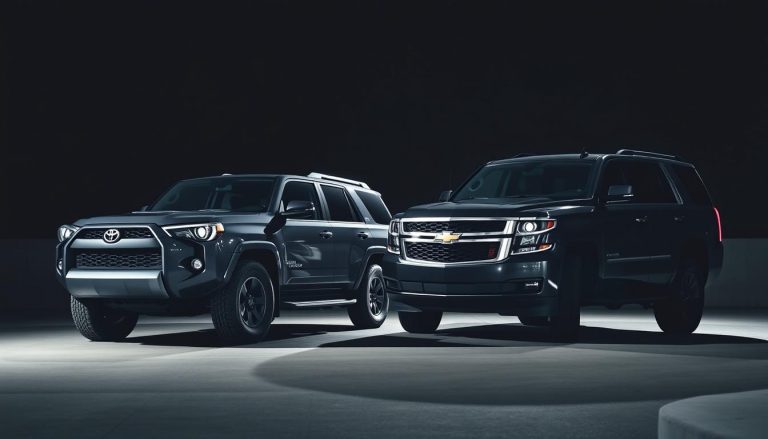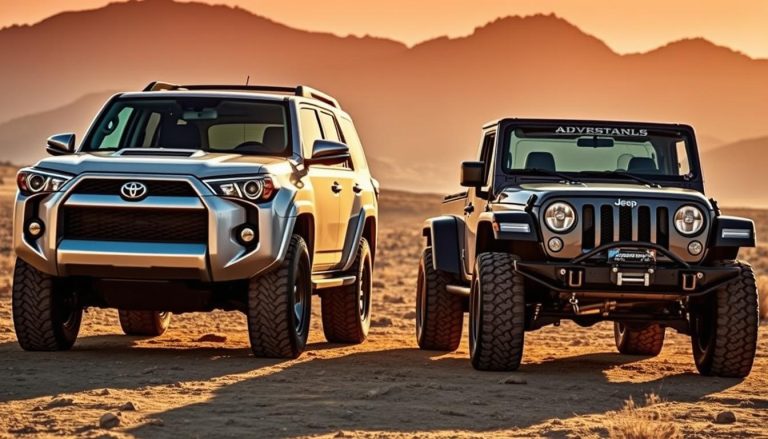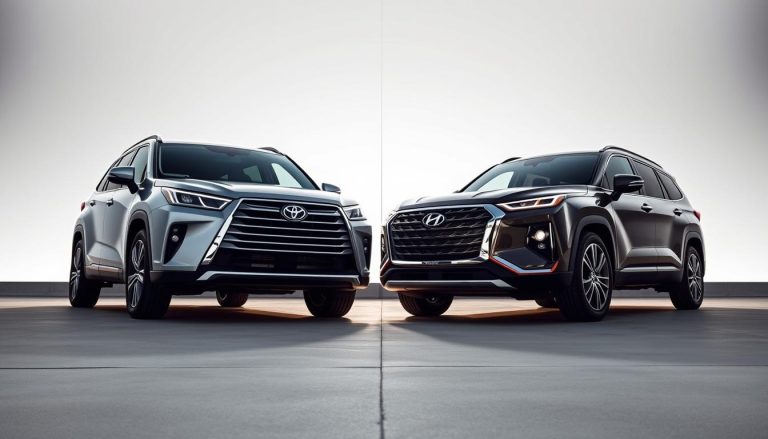Toyota Highlander vs VW Atlas: SUV Showdown
The midsize SUV market is getting more exciting with the Toyota Highlander and Volkswagen Atlas. Families in the U.S. are looking for the best three-row SUV. They want one that’s good at performance, comfort, and being practical. We’ll compare these two popular models, looking at their strengths and what makes them special.
At the 2023 Chicago Auto Show, both SUVs showed off their new features. This caught the attention of car lovers everywhere. Each SUV has its own unique qualities, making the Highlander vs Atlas choice important for families.
We’ll cover everything about these midsize SUVs. This includes design, performance, technology, and value. Whether you’re a growing family or love adventures, knowing the differences between the Toyota Highlander and Volkswagen Atlas is key. It helps you choose the right car for you.
Our aim is to give you a clear, detailed look at these two amazing SUVs. We’ll talk about their good points and any downsides. Get ready for a thrilling look into the world of family-friendly cars.
Introduction to the Battle of Three-Row Giants
The midsize SUV segment is huge in the family vehicle market. In 2024, the Toyota Highlander and Volkswagen Atlas stand out. These three-row SUVs are top choices for families and adventure lovers.
Market Position and Segment Overview
Family vehicles have changed a lot. The Highlander and Atlas offer a mix of practicality and power. They aim to meet the needs of families and those who love to explore.
- Ideal for families of 5-7 passengers
- Robust cargo capacity
- Advanced safety features
- Comfortable long-distance travel
2024 Model Year Updates
The 2024 models of these SUVs have big upgrades. Toyota and Volkswagen have added better tech, more fuel efficiency, and stylish designs.
Target Audience Comparison
Both SUVs are great for families, but they attract different buyers. The Highlander is known for its reliability and value. The Atlas offers a European driving feel.
Modern families demand more than just transportation – they need a versatile companion for everyday adventures.
These family haulers are perfect for carpooling, road trips, or weekend chores. They offer the space, comfort, and power that today’s drivers want.
Exterior Design and Styling Differences
In the world of midsize SUVs, the Volkswagen Atlas and its rivals are unique. Each has its own look that appeals to different tastes and styles.
The Volkswagen Atlas has a strong and bold design. Its big front grille and sharp lines make it stand out. It’s a mix of power and modern style.
- Prominent rectangular grille with horizontal chrome accents
- Sleek LED headlight design with distinctive daytime running lights
- Sculpted side panels that emphasize athletic proportions
- Contemporary wheel designs ranging from 18 to 20 inches
Visual drama meets practical design in the Volkswagen Atlas exterior. It looks both sleek and tough. Its lines go from front to back, making it eye-catching.
“Design is not just what it looks like and feels like. Design is how it works.” – Steve Jobs
Volkswagen’s engineers worked hard on the Atlas’s design. It shows they care about looks and function. The Atlas is a strong player in the midsize SUV world.
Engine Performance and Powertrain Options
When comparing the Toyota Highlander and Volkswagen Atlas, engine performance is key. These three-row SUVs offer different powertrain options. They meet the needs of various drivers.
Toyota Highlander Engine Specifications
The Toyota Highlander has impressive engine options. Buyers can pick from:
- A standard 3.5-liter V6 engine producing 295 horsepower
- A robust hybrid powertrain generating 243 combined horsepower
- The Grand Highlander’s Hybrid Max version boasting 362 horsepower
Volkswagen Atlas Power Delivery
The Volkswagen Atlas takes a more traditional engine approach. Its lineup includes:
- A base 2.0-liter turbocharged four-cylinder engine
- A more powerful 3.6-liter V6 option
Transmission and Drivetrain Comparison
Towing capacity is important for SUV buyers. The Toyota Highlander can tow up to 5,000 pounds. The Volkswagen Atlas also has a similar towing capacity.
Both SUVs offer smooth transmission experiences. The Highlander has an 8-speed automatic. The Atlas has an 8-speed transmission for responsive performance in all driving conditions.
Fuel Economy and Efficiency Ratings
When we look at the Toyota Highlander and Volkswagen Atlas, fuel economy is key. It matters a lot to those who watch their budget and care about the planet. The Highlander is a standout with its hybrid powertrains, showing great efficiency in its range.
The Toyota Highlander has various engine options to meet different needs. Its hybrid model is a real winner in fuel economy. It offers great mileage for a three-row SUV. Here’s what you can expect:
- Hybrid models achieve up to 36 mpg in the city.
- They also get around 35 mpg on the highway.
- They have a lower carbon footprint than most SUVs.
The Volkswagen Atlas is strong in performance but falls short in fuel efficiency. Its gasoline engines use more fuel, usually between 20-23 mpg overall.
| Vehicle Model | City MPG | Highway MPG | Combined MPG |
|---|---|---|---|
| Toyota Highlander Hybrid | 36 | 35 | 35.5 |
| Volkswagen Atlas | 21 | 25 | 23 |
Fuel economy differences can lead to big savings over time. The Highlander’s hybrid tech cuts down on fuel costs and environmental harm. It’s a great choice for those who care about the planet.
“Efficiency isn’t just about numbers—it’s about smart engineering and responsible driving.” – Automotive Efficiency Expert
Interior Quality and Materials
Car lovers will find a lot to talk about when comparing the Toyota Highlander and Volkswagen Atlas. These SUVs have different designs and materials. This makes them stand out in the market.
Dashboard Layout and Design
Both SUVs have unique interior designs. The Highlander goes for a simple, functional look. It has clean lines and easy-to-use controls.
The Atlas, on the other hand, has a more complex design. It focuses on looks and technology.
- Highlander: Minimalist dashboard with ergonomic control placement
- Atlas: Intricate dashboard with layered design elements
- Ambient lighting options available in both models
Material Quality Assessment
When it comes to interior quality, these SUVs are top-notch. The Grand Highlander has bronze-colored accents and suede-like seats. This adds to its luxury feel.
The Atlas has satin-finish wood-look trim and a 30-color ambient lighting system. It’s a big deal for interior quality.
Fit and Finish Comparison
Craftsmanship is key in this comparison. Toyota is known for its precision, with tight panel gaps and smooth material transitions. Volkswagen also shows German engineering skill, with a strong and refined interior.
The battle of interior quality comes down to personal preference: Toyota’s functional elegance versus Volkswagen’s technological sophistication.
Highlander vs Atlas: Space and Comfort
Looking at three-row SUVs like the Highlander and Atlas, comfort is key for families. Both have big interiors for different needs, but they’re not the same.
The Toyota Highlander and Volkswagen Atlas have different ways to make you comfortable. Highlander has a more detailed interior that feels a bit smaller. Atlas has a bigger cabin.
- Highlander seating features ergonomic design with premium fabric options
- Atlas offers wider seat configurations with enhanced lateral space
- Both SUVs provide multiple adjustment settings for optimal comfort
Legroom is a big deal in the Highlander vs Atlas fight. Atlas has about 2-3 inches more legroom in the second row. This is great for families with tall teens or adults. Highlander, on the other hand, has better seat shape and support.
When choosing between these SUVs, think about what you like most. The best way to decide is to try them out yourself. See which one feels right for your family.
Technology and Infotainment Features
In the SUV market, technology is key to making drivers happy. The Toyota Highlander and Volkswagen Atlas stand out with their top-notch infotainment features. These features make them leaders in today’s cars.
Touchscreen Interface Showdown
Both SUVs have advanced display tech that makes driving better. The Highlander has a 12.3-inch touchscreen that’s easy to use, inspired by Toyota’s trucks. The Atlas has a 12-inch touchscreen with a modern look, like Volkswagen’s electric cars.
Connectivity Options
- Toyota Highlander connectivity features:
- Wireless Apple CarPlay
- Android Auto integration
- Built-in navigation system
- Volkswagen Atlas connectivity highlights:
- Advanced smartphone mirroring
- Multiple USB-C ports
- Wireless charging capability
Driver Assistance Technologies
The tech goes beyond fun, with smart safety features. Toyota’s system has advanced voice commands and safety predictions. The Atlas has its own smart driver support, focusing on safety and ease.
Modern SUVs are no longer just about transportation—they’re mobile technology hubs designed to keep drivers connected and protected.
Second-Row Passenger Experience
When looking at three-row SUVs, comfort for passengers is key for families. The Toyota Highlander and Volkswagen Atlas both offer great second-row experiences. Each has its own strengths for different passenger needs.
Volkswagen’s Atlas shines with lots of legroom, perfect for families with taller members. Its adjustable seats make it comfy for both adults and teens.
- Atlas offers 42.4 inches of second-row legroom
- Panoramic moonroof adds extra light
- Seats can be adjusted in many ways
The Toyota Highlander has its own set of features. It’s a bit smaller but focuses on comfort with smart design and top-notch materials.
| Feature | Volkswagen Atlas | Toyota Highlander |
|---|---|---|
| Second-Row Legroom | 42.4 inches | 40.6 inches |
| Seat Adjustability | High | Moderate |
| Climate Control | Dual-Zone | Dual-Zone |
“Comfort isn’t just about space—it’s about creating an environment where every passenger feels welcomed,” says automotive expert Michael Roberts.
Both SUVs show that comfort in the second row is more than just numbers. They focus on design, materials, and smart use of space. This makes them great for families.
Third-Row Accessibility and Space
Families looking for big three-row SUVs know how key third-row comfort and access are. The Toyota Highlander and Volkswagen Atlas are top contenders. They each offer unique ways to enhance the passenger experience.
Entry and Exit Convenience
Getting into the third row can be tough. But both SUVs have smart solutions. The Volkswagen Atlas has:
- Sliding second-row seats for easier access
- Wide-opening rear doors
- Flexible seat configurations
The Toyota Highlander offers:
- Integrated step plates
- Strategically placed grab handles
- One-touch second-row seat movement
Passenger Comfort Specifications
Comfort levels show small but important differences. A close look at the space shows:
| Feature | Toyota Highlander | Volkswagen Atlas |
|---|---|---|
| Third-Row Legroom | 27.7 inches | 33.7 inches |
| Third-Row Headroom | 35.3 inches | 38.3 inches |
| Seat Recline Option | Limited | Available |
The Volkswagen Atlas has a bit more room in the third row. This makes it a great choice for families needing lots of space. Comfort is key when carrying many passengers.
Cargo Capacity and Storage Solutions
Family haulers need lots of cargo space. The Toyota Highlander and Volkswagen Atlas deliver just that. They are perfect for busy families, with great storage for everyday adventures and long trips.
Cargo space is key for both vehicles. They offer almost the same space behind the third row, with 20.6 cubic feet. But, when folding down the seats, the Toyota has a bit more room:
- Toyota Highlander: 97.5 cubic feet of total cargo space
- Volkswagen Atlas: 96.8 cubic feet of total cargo space
Both SUVs have a flat load floor. This makes it easy to carry big items and ensures a smooth surface for loading. Families will love how easy it is to manage their cargo.
Storage solutions go beyond just space. They have smart compartments and designs that make life easier. You’ll find many storage bins, under-floor spots, and seats that can change to fit your needs.
Versatility meets functionality in these cargo-friendly SUVs.
Whether it’s a weekend camping trip or daily errands, these SUVs have enough space. They fit your lifestyle perfectly.
Safety Features and Crash Test Ratings
When looking at midsize SUVs like the Toyota Highlander and Volkswagen Atlas, safety is key for families. Both vehicles focus on keeping passengers safe with top-notch safety systems and tech.
These two models stand out in SUV comparisons. They offer strong safety packages to protect drivers and passengers in different situations.
Standard Safety Equipment
Every midsize SUV has basic safety features that are vital for safety:
- Multiple airbag systems
- Anti-lock braking system (ABS)
- Electronic stability control
- Tire pressure monitoring
- Rearview cameras
Advanced Driver Assistance Systems
The Toyota Highlander and Volkswagen Atlas take safety further with advanced tech:
- Adaptive cruise control
- Lane departure warnings
- Automatic emergency braking
- Blind-spot monitoring
- Pedestrian detection systems
Groups like IIHS and NHTSA give both SUVs high safety ratings. This shows their dedication to keeping passengers safe with the latest safety tech.
Handling and Driving Dynamics
When we look at the Toyota Highlander and Volkswagen Atlas, how they drive is key. Each car has its own way of handling, fitting different drivers and roads.
The Toyota Highlander gives a smooth ride and predictable handling. Its steering is sharp, making city driving easy. Here are some key points about its handling:
- Precise steering response in city driving
- Stable highway performance
- Comfortable ride quality
- Moderate cornering capabilities
The Volkswagen Atlas has a sportier feel, thanks to its European design. It handles well on highways and corners lightly. Its suspension balances comfort and sportiness.
| Handling Characteristic | Toyota Highlander | Volkswagen Atlas |
|---|---|---|
| Steering Responsiveness | Smooth and Predictable | Precise and Athletic |
| Suspension Tuning | Comfort-Oriented | Performance-Balanced |
| Cornering Ability | Moderate | Sporty |
Both SUVs offer great engine performance for different lifestyles. The Highlander is perfect for those who want a smooth ride. The Atlas is for those who enjoy a more spirited drive.
Price Comparison and Value Proposition
The Highlander vs Atlas debate isn’t just about speed. It’s also about how much you get for your money. Buyers want to know if they’re making a smart choice.
Looking at prices, we see Toyota and Volkswagen aiming at different buyers. They’ve set their prices to fit various needs and wants.
Trim Level Insights
Each SUV has many trim levels. These are made for different budgets and tastes:
- Toyota Highlander Trims:
- L (Base Model)
- LE
- XLE
- Limited
- Platinum
- Volkswagen Atlas Trims:
- SE
- SE with Technology
- SEL
- SEL Premium
Standard Features by Price Point
Let’s look at what you get at each price level:
| Price Range | Highlander Features | Atlas Features |
|---|---|---|
| Entry Level | 8-inch touchscreen, Toyota Safety Sense | 6.5-inch touchscreen, App-Connect |
| Mid-Range | Leather seats, Power Driver’s Seat | Leatherette upholstery, Dual-zone climate control |
| High-End | Premium JBL Audio, Panoramic Sunroof | Digital Cockpit, Advanced Safety Features |
Comparing Highlander and Atlas shows both offer great deals at various prices. Your choice will depend on what you want, how much you can spend, and your personal preferences.
Maintenance Costs and Reliability
Thinking about buying an SUV? Maintenance costs and reliability are key. The Toyota Highlander and Volkswagen Atlas offer different experiences. These can affect your budget and how worry-free you’ll feel.
Toyota is known for being reliable. The Highlander often tops dependability surveys. This means lower maintenance costs and fewer surprise repairs for owners.
- Average annual maintenance cost for Toyota Highlander: $489
- Typical service intervals: Every 5,000-7,500 miles
- Warranty coverage: 3-year/36,000-mile basic, 5-year/60,000-mile powertrain
The Volkswagen Atlas has a different story. It’s well-engineered but might need more maintenance and cost more to fix than the Highlander.
| Maintenance Aspect | Toyota Highlander | Volkswagen Atlas |
|---|---|---|
| Average Annual Maintenance Cost | $489 | $673 |
| Reliability Rating | Excellent | Good |
| Typical Major Repair Frequency | Low | Moderate |
Volkswagen Atlas owners should budget for slightly higher maintenance expenses and potentially more frequent service visits. Regular maintenance and proactive care can help mitigate long-term reliability concerns for both vehicles.
Potential buyers should look into extended warranties and check specific model years for reliability. The Toyota Highlander is more reliable, but the Volkswagen Atlas is a good choice for those who invest in regular maintenance.
Conclusion
The Toyota Highlander and Volkswagen Atlas are two top three-row SUVs. They each have their own strengths. This makes choosing the right one exciting and detailed for buyers.
Drivers who love performance and tech will find great options in these SUVs. The Highlander is known for its fuel efficiency and tech features. On the other hand, the Atlas offers more comfort and a stylish interior.
Choosing between these SUVs depends on what you need most. If you need lots of space, the Highlander might be better. But if you want a luxurious ride, the Atlas is the way to go. Both have great safety features, drive well, and are designed for families.
Before making a decision, test drive both SUVs. Think about what you really need and what you can afford in the long run. The Highlander vs Atlas comparison shows that the best choice depends on your personal taste and lifestyle.
FAQ
Which SUV offers better overall value for families?
Both the Toyota Highlander and Volkswagen Atlas are great choices. The Highlander is known for its reliability and resale value. On the other hand, the Atlas has a bigger interior and is priced well.
Your decision should consider what your family needs. Think about cargo space, budget, and how long you plan to keep the SUV.
How do the fuel economy ratings compare between the Highlander and Atlas?
The Toyota Highlander, including its hybrid, is more fuel-efficient. It gets around 21-24 mpg combined. The Atlas gets 18-22 mpg combined.
The Highlander Hybrid is the clear winner for those who want to save on gas. It gets about 36 mpg combined.
Which SUV has a better third-row seating experience?
The Volkswagen Atlas offers a more comfortable third row. It has more legroom and easier access. The Highlander’s third row is good but not as spacious.
The Atlas is better for families with older kids or those who use the third row often. It provides more comfort for adult passengers.
Are there hybrid options available for these SUVs?
Yes, the Toyota Highlander has a strong hybrid option. The Volkswagen Atlas does not have a hybrid version yet. If you want a hybrid, the Highlander is the better choice.
How do the safety ratings compare between the two SUVs?
Both SUVs have excellent safety ratings from IIHS and NHTSA. Toyota’s Safety Sense suite gives it a slight edge. But both offer great safety features and airbags for family protection.
Which SUV offers more cargo space?
The Volkswagen Atlas has more cargo space. It offers about 96.8 cubic feet when the rear seats are folded. The Highlander has 84.3 cubic feet.
The Atlas is better for families needing lots of storage. It’s more versatile for big cargo needs.
What are the starting prices for these SUVs?
The Highlander starts at around ,000-,000. The Atlas starts at ,000-,000. Prices go up with trim levels and options.
Both offer various trims to fit different budgets. Fully loaded models can cost over ,000.
Which SUV has better reliability ratings?
Toyota is known for its reliability, and the Highlander gets top marks. The Volkswagen Atlas has improved but Toyota’s reputation is stronger.

